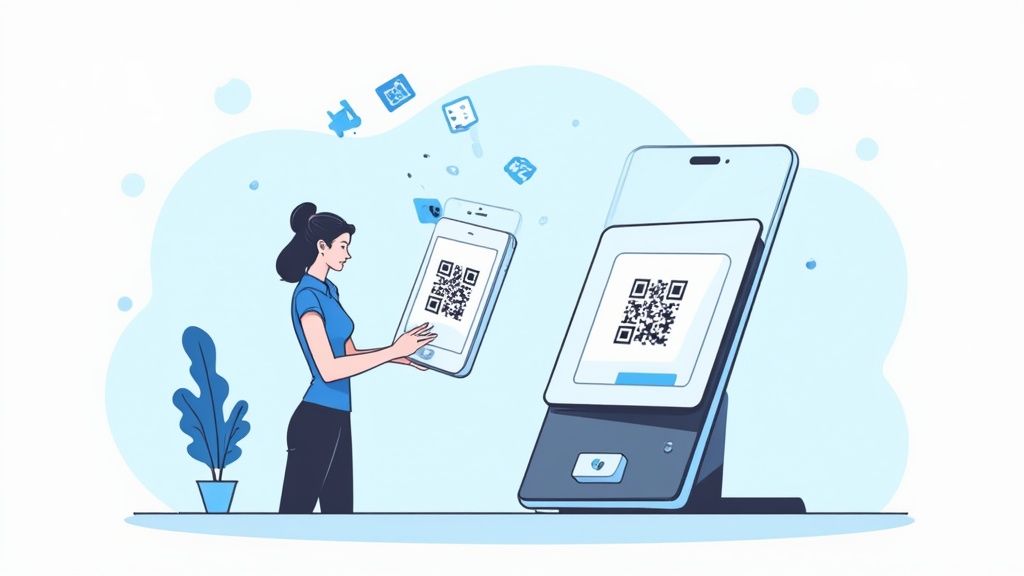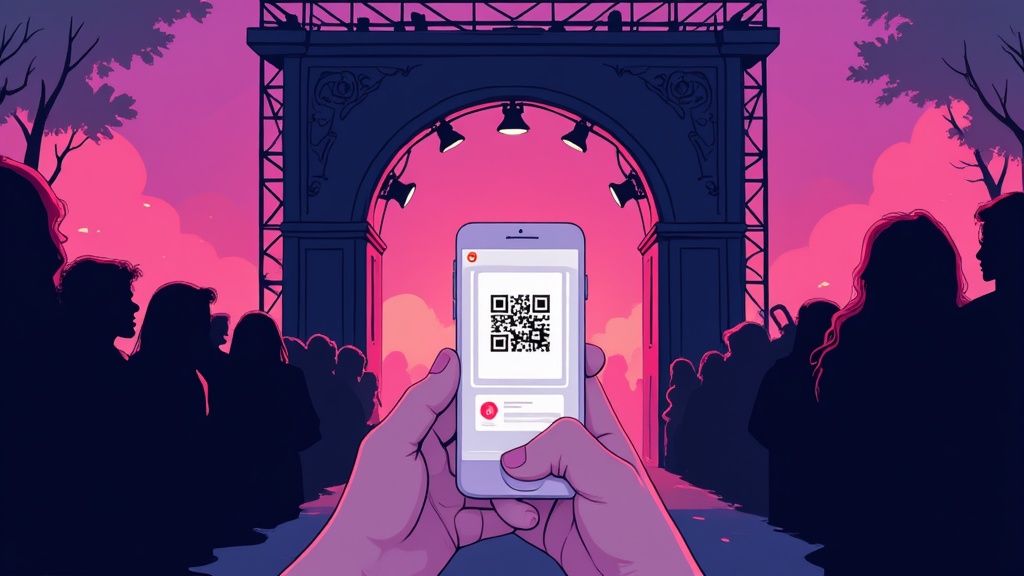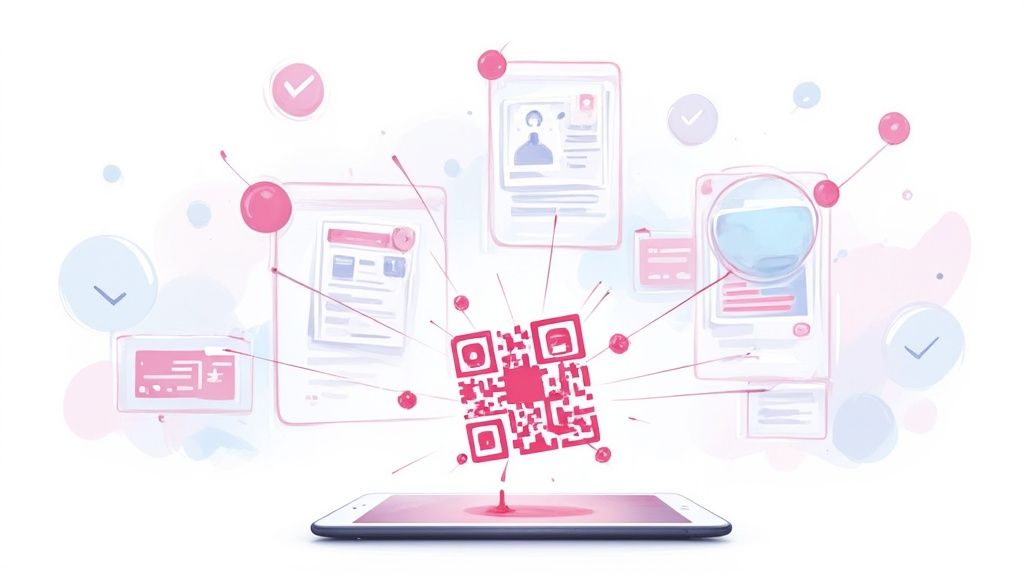Remember when QR codes were just a quirky tech novelty? Those days are long gone. In 2025, these powerful squares are the unsung heroes of digital strategy, seamlessly connecting our physical and online worlds.
From instant payments to exclusive marketing campaigns, they’ve become an essential tool for smart businesses. But not all QR code strategies are created equal. Many businesses still use them in basic, uninspired ways, missing out on their full potential for engagement and data collection.
We’re moving past the obvious and diving deep into seven innovative examples of qr codes that showcase not just what they do, but how they achieve incredible results. Get ready to discover replicable tactics and strategic insights you can use to make your next QR campaign a standout success. We’ll explore how platforms like QR Star empower these applications with dynamic, trackable, and customizable codes that drive real engagement and provide actionable analytics.
1. Contactless Payment QR Codes
Of all the real-world examples of QR codes, contactless payments are arguably the most transformative. This system allows customers to simply scan a code with their smartphone to complete a transaction, eliminating the need for cash or physical cards. The QR code securely contains all necessary merchant and transaction details, linking directly to a customer’s mobile wallet or banking app for an instant, seamless payment experience.

This method has seen massive adoption globally. In China, apps like Alipay and WeChat Pay process billions of transactions daily, making QR code payments a standard part of life. In the U.S., Square and PayPal have successfully integrated QR codes into their point-of-sale systems for retailers and restaurants. Meanwhile, India’s Unified Payments Interface (UPI) has revolutionized its digital economy, with platforms like Paytm making QR code payments accessible to millions.
Strategic Breakdown
Contactless payment QR codes succeed by prioritizing speed, security, and accessibility. They lower the barrier to entry for digital payments, as businesses don’t need expensive card terminals, and customers only need a smartphone. This approach streamlines the checkout process, reducing wait times and improving the overall customer experience. By connecting a simple scan to a complex financial transaction, they make purchasing feel effortless.
Key Insight: The power of a payment QR code is its ability to turn a customer’s personal device into a secure payment terminal. This decentralizes the transaction point, making commerce more flexible and efficient for everyone involved.
Actionable Takeaways
Ready to implement QR code payments? Here’s how to do it right:
- Prioritize Visibility: Place your QR code in a clear, well-lit, and easily accessible location at the point of sale. The code’s size and design are crucial for a quick scan. For more tips on creating effective codes, you can find helpful information on how to design a scannable QR code.
- Offer Clear Instructions: Not everyone is familiar with the process. A simple sign like “Scan to Pay” can guide customers and speed up checkout.
- Provide Fallbacks: Always have an alternative payment method available in case of technical issues with a customer’s phone or your system.
2. Restaurant Menu QR Codes
One of the most widespread and recognizable examples of QR codes is the digital restaurant menu. This innovation replaces traditional physical menus with a simple code that diners scan with their smartphones to view the menu online. This touchless solution gained immense popularity as a health and safety measure and has remained a staple for its efficiency and ability to offer a dynamic dining experience.

This technology has been adopted across the entire food service industry. Global chains like McDonald’s and Starbucks use QR codes to provide quick access to their menus and nutritional information. Meanwhile, local eateries leverage platforms like Toast and Square to create interactive digital menus that often include ordering and payment features directly from the table. Even fine dining establishments use them to present extensive wine lists with detailed pairing suggestions.
Strategic Breakdown
Restaurant menu QR codes excel by modernizing the dining experience, making it more interactive and efficient. They reduce printing costs and allow for real-time menu updates, enabling restaurants to instantly add specials or remove out-of-stock items. For restaurants aiming to streamline operations and offer digital payment options, integrating QR codes with a POS software can revolutionize ordering and payment. This seamless integration enhances operational workflow from the customer’s table to the kitchen.
Key Insight: The menu QR code transforms a static piece of paper into a dynamic, interactive digital platform. This shift empowers restaurants to control the customer journey, upsell items with high-quality visuals, and gather valuable data on diner preferences.
Actionable Takeaways
Want to implement a digital menu system? Follow these key steps:
- Optimize for Mobile: Ensure your digital menu is fast-loading, easy to navigate on a small screen, and features a clean, readable design. A poor mobile experience will frustrate customers.
- Include Rich Content: Go beyond plain text. Use high-quality, appetizing photos and detailed descriptions for each dish to entice customers and drive sales.
- Keep Physical Backups: Always have a few physical menus available for customers who may be less tech-savvy or experience phone issues. This ensures inclusivity and a smooth experience for everyone.
3. Event Ticketing and Check-in QR Codes
Among the most practical examples of QR codes, digital ticketing has completely revolutionized how we access events. This system replaces paper tickets with a unique QR code sent directly to an attendee’s smartphone. Each code contains secure, encrypted ticket information, allowing event staff to scan it for instant verification, streamlining entry and virtually eliminating fraud.

This technology has become the industry standard for major ticketing platforms and venues worldwide. Companies like Ticketmaster and Eventbrite have built their entire mobile experience around QR code-based tickets for concerts, sporting events, and festivals. From local conferences to massive international trade shows, the simplicity of scanning a phone screen has made long lines and counterfeit tickets a thing of the past.
Strategic Breakdown
The success of QR code ticketing lies in its ability to merge security with convenience. Each dynamic QR code is unique and can be tracked, making it incredibly difficult to counterfeit or resell without authorization. This system also digitizes the entire check-in process, providing event organizers with real-time data on attendance and entry flow. For attendees, it means no more worrying about losing or forgetting a physical ticket.
Key Insight: A QR code ticket transforms an attendee’s smartphone into a secure key for an event. This not only simplifies entry but also creates a direct digital connection between the organizer and the guest for future communication and engagement.
Actionable Takeaways
Looking to use QR codes for your next event? Follow these steps for a smooth experience:
- Ensure High Scannability: Design your QR code with sufficient contrast and size to be easily scanned from a phone screen, even if the screen is cracked or has low brightness.
- Train Your Staff: Equip your entry staff with reliable scanners and train them on the check-in process, including how to handle common scanning errors or validation issues.
- Have Backup Plans: Always have a manual check-in method, like searching by name or email, as a fallback for guests whose phones have died or who are experiencing technical difficulties.
4. Product Authentication and Anti-Counterfeiting QR Codes
Among the most critical examples of QR codes are those used for product authentication, serving as a powerful weapon against counterfeiting. These security-focused codes are embedded directly onto product packaging or labels. When scanned, they link to a secure, often blockchain-protected, database that verifies an item’s legitimacy by revealing its manufacturing details, supply chain history, and official verification status.
This technology empowers both consumers and retailers to confirm they have a genuine product with a simple scan. Luxury brands like the LVMH Group use it to protect high-value goods, while pharmaceutical giants like Pfizer deploy it to ensure patient safety through track-and-trace systems. Similarly, electronics and apparel companies use these QR codes to build consumer trust and safeguard their brand reputation from the pervasive threat of fake goods.
Strategic Breakdown
Product authentication QR codes succeed by transforming a static product into an interactive, verifiable asset. Each code is unique to the individual item, creating a digital fingerprint that is nearly impossible for counterfeiters to replicate at scale. This strategy shifts the power of verification directly into the hands of the consumer, building a direct line of trust between the brand and its customers while simultaneously providing valuable supply chain data.
Key Insight: The true value of an authentication QR code is its ability to create a unique, verifiable digital identity for a physical product. This one-to-one link makes the supply chain transparent and empowers every person to become a brand protector.
Actionable Takeaways
Looking to protect your products with QR codes? Here’s how to do it effectively:
- Integrate Multi-Layer Security: Don’t rely on the QR code alone. Combine it with tamper-evident labels or holographic seals so it’s obvious if the code has been compromised.
- Educate Your Customers: Create clear, simple instructions on your packaging and website explaining how to scan the code and what to look for to verify authenticity. An uninformed customer is an unprotected one.
- Use Dynamic, Trackable Codes: Employ dynamic QR codes that can be updated and tracked. This allows you to monitor scanning activity, identify potential counterfeit hotspots, and even deactivate codes associated with fraudulent products.
5. WiFi Connection QR Codes
Among the most practical examples of QR codes, WiFi connection codes stand out for their sheer convenience. This simple yet powerful application allows users to connect to a wireless network by just scanning a code, completely removing the tedious process of finding a network and manually typing in a complex password. The QR code securely bundles the network name (SSID), password, and encryption type, which smartphones instantly recognize and use to join the network.
This method has become a staple in customer-facing environments. Hotels place them in guest rooms for seamless internet access, while coffee shops and co-working spaces use them to provide hassle-free connectivity for patrons. It’s also a popular solution for office visitor networks and even for sharing a home guest network with friends without revealing the password. The hospitality and retail industries, in particular, have popularized this approach to enhance the customer experience.
Strategic Breakdown
WiFi QR codes succeed by eliminating friction at a common point of frustration. The manual process of connecting to a new network is prone to errors, like typos in long passwords or selecting the wrong network. By automating this entire sequence with a quick scan, businesses improve guest satisfaction and reduce the support burden on staff who would otherwise be repeatedly asked for WiFi details. It transforms a functional necessity into a smooth, welcoming interaction.
Key Insight: The power of a WiFi QR code is its ability to trade a moment of user effort for a positive brand experience. It’s a small detail that communicates efficiency and a customer-first mindset.
Actionable Takeaways
Want to offer effortless WiFi access? Here’s how to do it effectively:
- Secure Your Main Network: Always create a separate, isolated guest network for your QR code. This protects your primary business network and its sensitive data from public access.
- Place Codes Strategically: Display the QR code where it is most needed and visible, such as on tables in a café, on the check-in desk at a hotel, or in meeting rooms for visitors.
- Rotate Credentials Periodically: For added security, change your guest network password and update the QR code every few months to prevent misuse by former visitors.
6. Social Media and Contact Sharing QR Codes
In the world of networking and digital identity, these are standout examples of QR codes that bridge the physical and digital divide. This approach encodes everything from a LinkedIn profile to a full digital business card (vCard) into a scannable code, allowing for instant, one-tap connections. Instead of manually searching for a profile or typing in contact details, a simple scan does all the work, streamlining networking and boosting social media engagement.
This method has become a staple for professionals and brands. LinkedIn’s “My QR Code” feature lets users instantly connect at conferences and meetings, eliminating the friction of swapping business cards. Similarly, Instagram’s scannable codes are used on product packaging, storefronts, and event posters to drive follower growth. Digital business card platforms like HiHello and Popl have also built entire business models around QR codes, enabling users to share comprehensive, interactive contact cards with a single scan.
Strategic Breakdown
The core strategy behind social media and contact sharing QR codes is frictionless connection. They remove the cumbersome steps of searching, typing, and potential spelling errors, making it remarkably easy for someone to follow a brand or save a contact. This immediacy is crucial in fast-paced environments like trade shows or networking events, where a moment’s delay can mean a lost opportunity. By embedding a direct call-to-action into a physical space, these codes turn passive observers into active connections.
Key Insight: A contact sharing QR code transforms a static piece of marketing material, like a business card or a flyer, into a dynamic gateway for digital interaction. It creates an immediate and actionable pathway to your online presence.
Actionable Takeaways
Ready to supercharge your networking? Here’s how to make it happen:
- Customize with Branding: Don’t just use a generic black-and-white code. Add your logo, brand colors, and a clear call-to-action like “Scan to Connect” or “Follow Us” to increase scan rates.
- Test Extensively: Before printing your code on hundreds of business cards, test it across multiple devices (iOS and Android) and with different QR code scanning apps to ensure it works flawlessly.
- Monitor Your Analytics: Use a dynamic QR code service to track how many scans your code receives. This data can provide valuable insights into where and when your networking efforts are most effective. You can learn more about leveraging QR codes in social media to maximize your reach.
7. Marketing Campaign and Lead Generation QR Codes
Of the many strategic examples of QR codes, their use in marketing and lead generation is one of the most impactful. These codes act as a powerful bridge between physical and digital marketing channels. A customer can scan a code on a printed ad, product packaging, or trade show banner and be instantly directed to a landing page, promotional offer, or lead capture form. This creates a seamless, interactive customer journey that is entirely trackable.
This approach has been famously used by major brands. Coca-Cola’s “Share a Coke” campaign used QR codes on bottles to unlock personalized digital content. Nike often integrates them into product launches to provide exclusive access to app features or behind-the-scenes content. Similarly, real estate agents place them on “For Sale” signs to give potential buyers instant access to property details and virtual tours, capturing leads in the process.
Strategic Breakdown
Marketing QR codes excel by adding a layer of digital interactivity to static offline assets. They transform a passive advertisement into an active engagement opportunity. By linking directly to a specific call to action, they remove friction from the customer journey, making it easier for users to sign up, redeem an offer, or learn more. Most importantly, dynamic QR codes provide invaluable analytics, allowing marketers to measure the exact ROI of their print and physical media spend.
Key Insight: A marketing QR code’s true strength is its ability to make offline campaigns measurable. It provides concrete data on engagement and conversion, turning traditional advertising from a guessing game into a data-driven strategy.
Actionable Takeaways
Want to use QR codes to supercharge your marketing? Here’s how to do it effectively:
- Offer a Clear Incentive: Give users a compelling reason to scan. Vague promises won’t work. Use clear calls to action like “Scan for 20% Off” or “Scan to Enter Our Giveaway.”
- Optimize the Destination: Ensure the landing page is mobile-friendly, loads quickly, and is directly relevant to the ad. A poor post-scan experience will negate the convenience of the QR code. For more ideas on how to use them effectively at events, check out these strategies for trade show lead capture.
- Track and Analyze: Use dynamic QR codes to track scan data, including location, time, and device type. Use this information to analyze campaign performance and optimize future efforts.
Ready to Create Your Own QR Code Success Story?
As we’ve explored, the most effective examples of QR codes share a common thread: they solve a problem, reduce friction, or create a moment of delight for the user. They are far more than pixelated squares; they are powerful gateways connecting the physical world to your digital ecosystem. From the immediate convenience of contactless payments and WiFi access to the strategic depth of lead generation and anti-counterfeiting measures, QR codes have proven their versatility and impact.
The journey through these real-world applications reveals a clear blueprint for success. It’s not about simply generating a code and placing it somewhere visible. True success comes from understanding your audience’s intent and designing an experience that feels seamless, valuable, and intuitive. The difference between a scanned code and an ignored one often comes down to context, clarity, and a compelling reason to engage.
Key Takeaways from Our QR Code Examples
To transform your own ideas into impactful campaigns, remember these core principles:
- Value First: Always ask, “What’s in it for the user?” Whether it’s instant access to a menu, a discount on their next purchase, or exclusive content, the value proposition must be immediate and clear. A QR code without a benefit is just visual noise.
- Context is King: The placement of your QR code dictates its purpose. A code on a product package serves a different function than one on a trade show banner or a restaurant table. Tailor the destination and call to action to fit the user’s specific environment and mindset at the moment of scanning.
- Branding Matters: A generic black-and-white code works, but a branded one performs. Incorporating your logo, colors, and a unique frame builds trust and reinforces your brand identity, making users more likely to scan.
- Dynamic is a Non-Negotiable: The strategic power of the examples of QR codes we’ve seen lies in their dynamic nature. The ability to update the destination link, track detailed analytics, and adapt your campaign in real-time without reprinting materials is essential for modern marketing and operations.
Your Next Steps to QR Code Mastery
Feeling inspired? The best way to understand the power of QR codes is to start using them. Begin with a small, manageable project. Think about a common point of friction for your customers or a simple process you could digitize. Could you replace a paper form with a digital one linked by a QR code? Or add a code to your business card that directs to your portfolio?
Use the strategies discussed in this article as your guide. Analyze the situation, define a clear objective, and build a user-friendly experience on the other side of the scan. Most importantly, embrace the data. Use the analytics from your dynamic QR codes to learn what works, refine your approach, and continuously improve the experience. By putting these powerful little squares to work, you’re not just sharing a link; you’re creating smarter, more engaging, and measurable interactions that will drive your success.
Ready to move from inspiration to implementation? QR Star provides all the tools you need to create, manage, and track the kind of powerful dynamic QR codes featured in these examples. Sign up today and start building your own QR code success story with our intuitive platform. Visit QR Star to begin.
